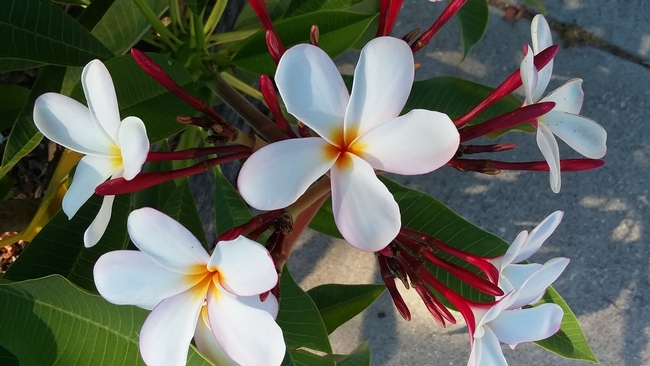- Author: Polly Nelson
- Editor: Noni Todd
Plumeria
By Polly Nelson UCCE Master Gardener
Common Name: Plumeria (Frangipani)
Scientific Name: Apocynaceae
Planting area: Depends on species, generally USDA zones 8-11
Size: Depends on species and if grown in ground or container.
Bloom Season: Spring-Fall
Exposure: Minimum 6 hours of full sun
Pruning needs: Minimal; to remove dead branches, maintain desired size and shape
Water needs: Moderate
Snapshot: Did you receive a lei in Hawaii and savor the scent? Plumerias may have been part of the lei, exuding a combination of jasmine, citrus and gardenia fragrance. Native to tropical America, the Plumeria genus is comprised of 11 species of shrubs and small trees. Branches are widely spaced, with thin, grey bark and milky sap when cut. They can be upright and compact, or open and sprawling. Fleshy leaves have an alternate pattern; shapes vary from round to pointed, glossy or smooth; positioned on the tips of the branches. Flowers are 2-4 inches in diameter and have five rounded, overlapping petals, in pink, red, white, and yellow color palettes. Fragrance may be strongest in the evening, to attract night-flying sphinx moth pollinators.
Plant in slightly acidic, well-drained soil, as Plumeria do not like “wet feet”. Container plantings should be placed in cactus mix. Water deeply and allow plant to dry out some before watering again. Stop watering once plants enter dormancy (winter); resume when new growth appears in spring. Fertilize with high phosphorus (10-30-10) solution every 1-2 weeks Spring through Fall. Too much nitrogen will result in more foliage and decreased blooms.
Propagate by seeds or cutting but know that cuttings are the easiest and most successful. Take 12-18 inch hardwood cuttings when dormant, allow the milky sap to dry 2-3 days, then place deeply in free draining soil mix with 1-1.5 inch tip above the soil line. Keep at approximately 70 degrees F.
Pests include: 1) Plumeria Rust, which affects foliage. Airborne spores spread by splashing rain or irrigation, appear as yellow specks on upper and undersides of leaves. Leaves can curl or otherwise distort. Treat by removing afflicted leaves, pick up dropped leaves, increase airflow around plants, and keep area weed free. 2) Spider mites may be treated with Neem oil.




